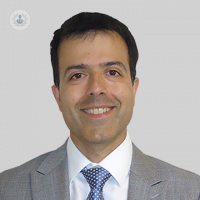Sinusitis: Q&A session with an ENT specialist
Written in association with:The sinuses are air-filled spaces within the bones of the face, over the cheeks, in between and above the eyes. Various theories exist regarding their function including temperature and humidity control of the air reaching the lungs, modifying voice quality production and lightening the weight of the skull.

What are the different types of sinus infection?
Acute sinusitis:
This usually occurs following a cold or upper respiratory infection and lasts for anything from one week to four weeks. The patient suffers from a thick green-yellow nasal discharge, pain and pressure over the cheeks, eyes and/or forehead, a blocked or congested nose and a high fever.
Chronic sinusitis:
This is an infective and inflammatory process affecting the sinuses which usually lasts in excess of 12 weeks. Patients typically suffer from nasal obstruction, headache, purulent nasal discharge, low-grade fever, reduced sense of smell, facial pain, lethargy and halitosis.
Recurrent acute sinusitis:
Patients suffer from frequent episodes of acute sinusitis with no symptoms whatsoever in between attacks.
What are the causes of sinusitis?
Upper Respiratory Tract Infections: Common colds or the flu are usually caused by a virus. When secondary bacterial infections occur, the mucus changes from clear to yellow to green, indicating blockage of the sinus openings.
Allergies and irritants: These include tree and grass pollen, house dust mite, airborne fungi, cat and dog and feathers. Even a tiny quantity inhaled into the nose can cause considerable inflammation of the nose and sinuses. Irritants include air pollution, diesel fumes, smoke, pesticides, disinfectants and household detergents.
Structural nasal/sinus problems: A deviated nasal septum, excessive swelling of the inner nasal lining or the presence of nasal polyps can cause a reduction in airflow passing towards the sinuses, leading to reduced oxygenation and the increased likelihood of developing an infection. Traumatic nasal injury is also another cause.
How do you diagnose and treat sinusitis?
Acute sinusitis is usually diagnosed clinically on the basis of a history and examination findings. Treatment with antibiotics and nasal decongestants help to reduce the swelling of the nasal and sinus lining and improve nasal airflow. Many patients find steam inhalations and/or salt water douches to be helpful in clearing out mucus.
Chronic sinusitis often requires longer-term treatment, to include nasal decongestants, antibiotics, intranasal steroid sprays/drops and antihistamines in patients with allergies. Often antibiotics will need to be given for several weeks before symptoms fully resolve.
Symptoms may persist despite the regular and persistent use of medical therapy. In such cases, surgery may have a role. Your GP will probably refer you on to an ENT specialist with an interest in rhinology, who may advise further investigations including allergy testing and possibly a CT scan of the sinuses, which will help your specialist decide if surgery may be necessary.
Surgery to treat chronic sinusitis
Surgery is normally only considered if medical treatment fails. The vast majority of sinus operations are performed entirely through the nose without the need for any external incisions, using nasal endoscopes to guide the surgeon to the areas of obstruction and disease.
The traditional surgical option is FESS (Functional Endoscopic Sinus Surgery). FESS requires a general anaesthetic and can usually be performed as a day case. More recently, a non-invasive method of opening the sinuses (balloon sinuplasty) has come available, which is extremely safe, effective and can sometimes be undertaken under local anaesthetic.
FESS
Surgical instruments are gently inserted into the nose to carefully remove the sinus blockage and to restore a clear drainage pathway. At the end of the operation, a light dressing may be required to prevent further bleeding; this is usually dissolvable.
Balloon Sinuplasty
A flexible guide wire and a high-grade surgical balloon are inserted into the nose, and once in place, the balloon is inflated under pressure to widen the sinus opening. At the end of the operation, the balloon is removed. Dressings are usually not necessary.
Recovery after sinus surgery
The operation is not usually too painful although simple painkillers may be needed occasionally.
It is important not to blow your nose for the first 48 hours following sinus surgery. Most doctors recommend the use of nose drops, sprays, ointments and salt water sprays after the operation. Saltwater douching is particularly useful as it keeps the nasal passages clear and free from a build-up of mucus or crusting during the healing process. Some mucus and blood-stained fluid may drain from your nose during the first week or two, and your nose will become steadily more blocked for 1-2 weeks due to swelling from the surgery. It is also important to stay away from dusty and smoky atmospheres while you are recovering and to avoid people with coughs and colds. If you are concerned about sinusitis, and would like to make an appointment with an ENT specialist, click here.


